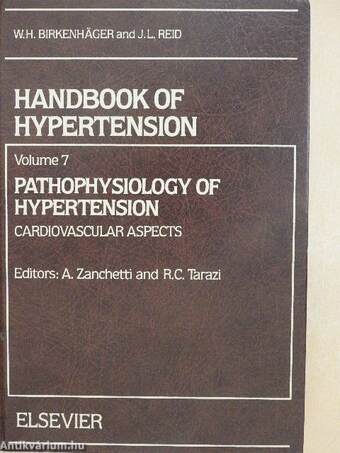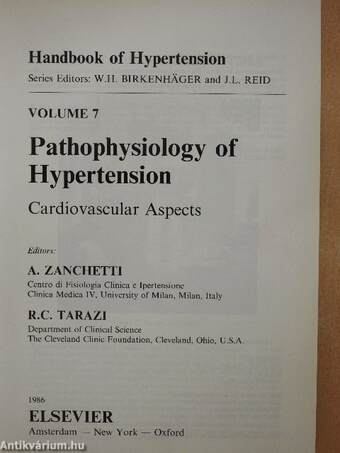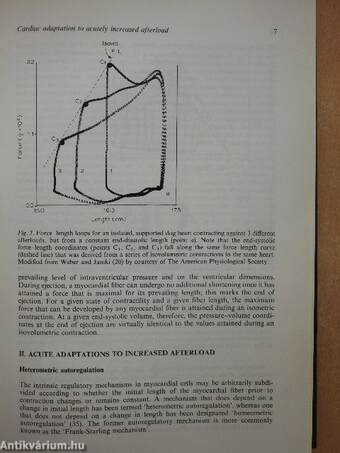1.067.317
kiadvánnyal nyújtjuk Magyarország legnagyobb antikvár könyv-kínálatát

VISSZA
A TETEJÉRE
JAVASLATOKÉszre-
vételek
Pathophysiology of Hypertension
Cardiovascular Aspects
| Kiadó: | Elsevier |
|---|---|
| Kiadás helye: | Amsterdam-New York |
| Kiadás éve: | |
| Kötés típusa: | Fűzött keménykötés |
| Oldalszám: | 517 oldal |
| Sorozatcím: | Handbook of Hypertension |
| Kötetszám: | 7 |
| Nyelv: | Angol |
| Méret: | 25 cm x 17 cm |
| ISBN: | 0-444-90421-2 |
| Megjegyzés: | Fekete-fehér fotókkal, ábrákkal. További szerzők a könyvben. |
naponta értesítjük a beérkező friss
kiadványokról
naponta értesítjük a beérkező friss
kiadványokról
Előszó
Foreword
The concept of the Handbook of Hypertension developed in the late 1970s from a widespread feeling that the diversity of interests and inputs into hypertension research did not lend... Tovább
Előszó
Foreword
The concept of the Handbook of Hypertension developed in the late 1970s from a widespread feeling that the diversity of interests and inputs into hypertension research did not lend themselves to publication in a single textbook. The Handbook of Hypertension has now come of age and is recognized as an authoritative source of information and reviews on clinical and research aspects of high blood pressure.
As we have previously observed, the scope of hypertension in man has developed over the last 30 years from the short-term care of a small number of hospitalized patients with severely elevated blood pressure and extensive target-organ failure to a major long-term community-health problem involving a substantial proportion of the population. It appeared possible at one time that the mechanisms involved in the pathogenesis of hypertension could be identified by a limited number of circumscript and straightforward experiments in laboratory animals. This is clearly not so. The field of experimental hypertension has, if anything, expanded even more than clinical practice.
We shared with our Publishers the view that the accumulation of biological and clinical knowledge in the field of hypertension had outgrown the limitations of the classical monograph. Moreover, the subject of hypertension by its very nature is a multidisciplinary one, attracting such diverse professionals as biochemists and public health workers, in addition to clinicians. When one tries to envisage what would happen to a single all-encompassing book, it is clear that it could never satisfy the different groups involved in high blood pressure. Some sections would become outdated rapidly while others would have a longer life-span. An alternative, to escape from the constraints of a single textbook and to reconcile the interests of both generaUsts and specialists, was to choose the format of a serial handbook.
The present work has resulted from lengthy deliberations and discussions with many clinicians and scientists. We believe that it will be of interest to many different groups including clinical investigators, house officers, general practitioners, biomedical students, pharmacologists, pharmacists, biological scientists, physiologists and epidemiologists.
In the overall design, three or perhaps four groups comprising 6 volumes each will be pubhshed. The first group was completed in 1985 (see page ii). The present volume on 'Pathophysiology of Hypertension — Cardiovascular Aspects' — edited by Alberto Zanchetti and the late Robert Tarazi is the first of two volumes on Pathophysiology. The second, Volume 8, will deal with Regulatory Mechanisms under the same Editorship. Listed below are the titles of further volumes currently in preparation. In addition, several volumes are under consideration and plans well advanced for the publication of revised or updated editions of earlier volumes:
Behavioral Aspects of Hypertension (Editor: S. Julius)
Hypertension during Pregnancy (Editor: P.C. Rubin)
Clinical Pharmacology — revised and updated (Editor: A.E. Doyle)
Clinical Aspects — revised and updated (Editor: J.I.S. Robertson)
Hypertension in the Elderly (Editors: A. Amery and J. Staessen)
Management of the Hypertensive Patient (Editors: F.R. Buhler and J.H. Laragh)
xiii Vissza
Tartalom
Contents
Foreword
W.H. Birkenhäger and J.L. Reid
Introduction xiii
A. Zanchetti
I. The heart and hypertension
1. Cardiac adaptation to acutely increased afterload 1
M.N. Levy and Y. Masuda
2. Biochemical regulation of myocardial hypertrophy 25
J. Wikman-Coffelt
3. Excitation-contraction coupling in hypertensive hypertrophy 53
F.M. Fouad-Tarazi and P.A. Khairallah
4. Cardiac responses to experimental chronic pressure overload 59
R. Jacob
5. Hypertension and the heart: clinical studies 84
B.E. Strauer
6. Cardiac reflexes in hypertension 102
P. Thoren
II. Hemodynamics in hypertension
7. Hemodynamic changes during development 117
F. Magrini
8. Blood pressure variability 125
G. Mancia and A. Zanchetti
9. Hemodynamics of hypertension 153
5. Julius and B. Egan
10. Hemodynamics in the spontaneously hypertensive rat 179
S. Lundin and M. Nordlander
11. Hemodynamics in renovascular and renal hypertension 199
Th.G. Coleman
12. Hemodynamics in mineralocorticoid hypertension 217
J. Conway
13. Hemodynamics in systolic hypertension 225
M.E. Safar and A.Ch. Simon
XLII
Contents XLIII
14. The elfects of ventricular hypertrophy on the coronary circulation 242
L.F. Hiratzka, D.G. Harrison, R.J Tomanek, Ch.L. Eastham, JV.C. Lamberth Jr and M.L. Marcus
15. The cerebral circulation in hypertension 253
5. Strandgaard, J. Olesen and O.B. Paulson
16. Hemodynamics in obesity 280
E. Reisin and E.D. Fröhlich
17. Hemodynamics in pregnancy and in pregnancy hypertension 298
S.N. Hunyor
III. The blood vessels in hypertension
18. Physiological mechanisms regulating peripheral vascular resistance 311
D.F. Bohr and R.C. Webb
19. Physiology of vascular smooth muscle 338
B. Johansson
20. The homeostasis of calcium in smooth muscle cells 357
M. Chiesi and E. Carafoli
21. Calcium entry blockers 375
C. Cauvin and C. van Breemen
22. Prostacyclin and vascular smooth muscle 408
G.J. Dusting, K.M. Mullane and S. Moncada
23. The structural responses of the vascular wall in experimental hypertension 427
G.L. Rorive, P.G. Carlier and J.M. Foidart
24. Common mechanisms of cell proliferation in hypertension and atherosclerosis ^^^
S.M. Schwartz
25. The microcirculation in hypertension 465
G. W. Schmid-Schönbein and Shu Chien
Index 491 - 517
Témakörök
- Orvostudomány > Kórélettan
- Idegennyelv > Idegennyelvű könyvek > Angol > Orvostudomány
- Orvostudomány > Általános orvosi, egyéb > Idegennyelvű
- Orvostudomány > Általános orvosi, egyéb > Kutatások, kísérletek
- Orvostudomány > Belgyógyászat > Általános > Idegennyelvű
- Orvostudomány > Belgyógyászat > Általános > Terápia
- Orvostudomány > Belgyógyászat > Általános > Betegségek > Szív- és érrendszeri
- Orvostudomány > Orvosi idegennyelvű könyvek > Általános orvosi
- Orvostudomány > Orvosi idegennyelvű könyvek > Belgyógyászat
- Orvostudomány > Orvosi idegennyelvű könyvek > Kórélettan










